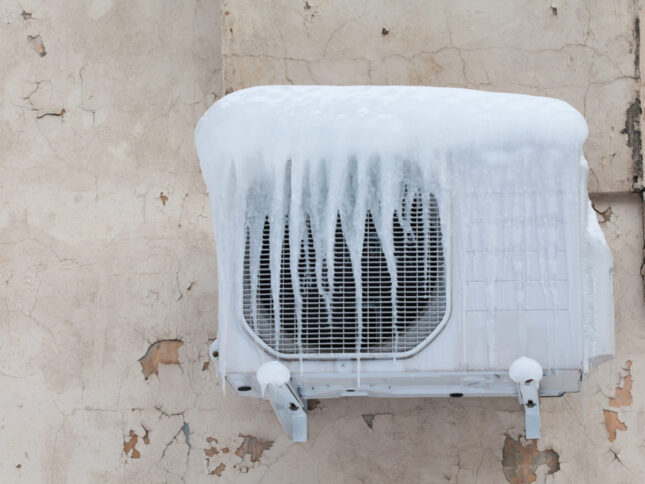How to Unfreeze a Frozen AC Pipe: Expert Guidance
How to Unfreeze a Frozen AC Pipe: Expert Guidance
Blog Article
Just how do you actually feel when it comes to Have a Frozen AC Line? Here’s How to Fix It?

Intro
Discovering that your air conditioning pipe is frozen can be concerning, particularly during hot summer season when you count on your a/c unit the most. Comprehending what to do in such a circumstance is important to prevent more damages to your air conditioning system and ensure your comfort indoors.
Recognizing the Causes
Several factors can contribute to the cold of an a/c pipe. Recognizing these reasons can aid you address the concern effectively.
Lack of Airflow
One usual reason for a frozen air conditioner pipe is inadequate airflow. When the air movement over the evaporator coil is restricted, it can create the coil to drop below freezing temperature level, leading to ice formation on the pipeline.
Low Refrigerant Levels
Inadequate cooling agent levels in your air conditioner system can likewise cause an icy pipe. Low refrigerant degrees can create the stress in the system to drop, resulting in the freezing of wetness on the evaporator coil.
Winter Conditions
In cooler environments, freezing temperature levels outside can contribute to the freezing of AC pipes. If your AC unit is not correctly insulated or if there are leaks in the ductwork, cold air can infiltrate the system, causing the pipe to ice up.
Dirty Air Filters
Filthy or clogged up air filters can restrict air flow in your AC system, bring about various problems, consisting of an icy pipeline. It's essential to change or clean your air filters consistently to make sure appropriate air flow and avoid ice build-up.
Indications of a Frozen Air Conditioner Pipe
Acknowledging the indicators of an icy AC pipeline is important for punctual action.
Lowered Airflow
If you discover a significant reduction in air movement from your vents, it could suggest an icy pipeline.
Ice Buildup on the Pipe
Noticeable ice buildup on the refrigerant line or the evaporator coil is a clear indicator of an icy a/c pipeline.
Weird Sounds from the Unit
Uncommon sounds, such as hissing or bubbling, coming from your air conditioning unit can indicate that there's ice present on the pipe.
Immediate Actions to Take
When confronted with an icy air conditioner pipeline, it's vital to act promptly to avoid additional damage to your cooling system.
Switching off the air conditioner
The initial step is to turn off your a/c to avoid the system from running and intensifying the problem.
Looking for Blockages
Evaluate the area around the indoor system for any type of obstructions that may be obstructing air flow, such as furnishings or drapes.
Defrosting the Pipe
You can make use of mild approaches like positioning towels taken in cozy water around the frozen pipe to help thaw it slowly.
Preventive Measures
Taking preventive measures can help avoid future events of an icy a/c pipeline.
When DIY Methods Fail
If your attempts to thaw the pipeline or address other problems are not successful, it's time to call an expert.
Value of Hiring a Professional HVAC Technician
A licensed HVAC service technician has the know-how and tools needed to detect and fix concerns with your AC system securely and effectively.
Regular Maintenance Checks
Schedule regular upkeep checks with a professional HVAC technician to make certain that your air conditioner system is running effectively.
Altering Air Filters
Routinely change or cleanse your air filters to stop air flow restrictions and keep optimal efficiency.
Protecting Exposed Pipes
If your air conditioner pipes are revealed to chilly temperature levels, think about protecting them to stop freezing during cold weather.
Seeking Professional Help
If DIY techniques fall short to deal with the problem or if you're unsure about how to continue, it's ideal to look for help from a qualified HVAC specialist.
Conclusion
Dealing with an icy AC pipeline can be a frustrating experience, yet understanding how to react can assist minimize damages and bring back convenience to your home. By comprehending the reasons, recognizing the indicators, and taking prompt action, you can efficiently address the issue and avoid future incidents.
What to Do If Your AC Line Is Frozen
Make Sure All Supply and Return Air Vents Are Open
If you notice problems with airflow, the first thing you should do is check your supply and return vents. Supply vents distribute clean, conditioned air throughout your home. As this air becomes stale, it’s pulled into the return vent, where it’s reconditioned before being sent back out through the supply vent.
When these vents are closed, air won’t flow in the home. Before examining your AC, check the vents in every room and ensure they’re all open.
Check for a Dirty Air Filter
Another possible cause of limited airflow is a dirty air filter. Your air conditioner’s filters catch elements you don’t want to breathe in, such as dirt and dust. Over time, filters can become clogged, ultimately blocking air from flowing in and out. The lack of airflow can then cause the entire coil to freeze and will completely restrict any air from moving through it. The AC may need to be powered off for one to two days to allow the coil to thaw after replacing the filter to allow proper functioning of the unit. This debris can also accumulate on your AC’s evaporator coil, requiring a more serious repair. In general, air filters should be cleaned regularly (about every two weeks).
Assess Your Outdoor Unit
In addition to checking your AC, assessing the outdoor unit is a good idea. Also known as the condensing unit, it works with your interior unit to release heat outside. An issue with the outdoor unit can result in rising internal temperatures.
Overgrown Shrubs or Clogged Leaves
From leaves and twigs to shrubs and debris, there’s no shortage of outdoor elements that can accumulate around your condensing unit. When these elements get lodged inside the unit, they can block airflow. Fortunately, removing the blockage can solve the problem.
Sounds of a Broken Fan
Shrubs and leaves aren’t the only things that can impede your outdoor unit’s airflow. If the fan is broken, the unit won’t be able to properly get rid of heat — which means the internal temperature won’t go down. First, make sure the fan is spinning. If it is, check for the following sounds of a broken fan:
Buzzing Rattling Screeching Hissing Clicking Preventative Measures
Nobody wants to deal with a frozen AC line. In addition to causing problems with your air conditioner, they require professional repairs. On the bright side, there are preventative measures you can take to help ensure this issue doesn’t arise in the first place.
https://www.coopergreenteam.com/blog/what-to-do-if-ac-line-frozen

We had been shown that article on What Causes AC Pipes To Freeze? through an associate on another web address. Those who liked our article plz make sure you remember to share it. I treasure reading our article about How can I fix an air conditioner’s frozen pipe?.
Call Today Report this page